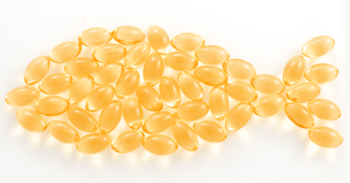The use of flaxseed in food and beverages, functional foods and dietary supplements has risen dramatically. Such increased popularity is related to the increasingly recognized benefits of flax’s rich omega-3 fatty acid, lignans (powerful phytonutrient phytoestrogens/antioxidants) and fiber content.
A typical flax profile is approximately 40 percent fat, being mostly omega-3 as alpha linolenic acid (ALA); 28 percent dietary fiber; 21 percent protein; 4 percent mineral ash; and 6 percent carbohydrates.1
And all the plant sources (see chart) are richer in omega 6 than omega 3, none having flax’s most desirable 3 to 1 omega-3 to omega-6 ratio.3
ALA, EPA, DHA
ALA is converted in the body to eicosapentaenoic acid (EPA) and, to a much lesser extent, docosahexaenoic acid (DHA).4,5 EPA and DHA, as such, are found abundantly in fish oil. Both of these longer chain omega 3 fatty acids are known for their salubrious effects on cardio-vascular health.6 However, flaxseed has also demonstrated impressive support for its heart health promoting benefits.
ALA Improves Heart Health
Below is a small list of scientific studies supporting the benefit of a high ALA diet derived from plant sources.
Supplementation with 8g/day ALA resulted in significantly lower systolic and diastolic blood pressure levels. There was observed a hypotensive effect of ALA, which may constitute another mechanism accounting, in part, for the apparent cardio-protective effect of this n-3 fatty acid.7
|
To get an idea how omega-3 ALA rich flaxseed is compared to other ALA rich foods, the following should be instructive. One and a half tsp. of ground flaxseed supplies 1,000 mg of ALA in 40 calories. One half tsp. of flaxseed oil supplies the same 1,000 mg ALA in 20 calories. To get the same 1,000 mg of ALA, the following amounts of other sources are needed: • Five walnut halves, providing 70 calories; • two tsps. canola oil, garnering 80 calories; • one tbs. of wheat germ or soybean oil, with 120 calories; • two ounces salmon, herring, albacore, two ounces of sardine, rainbow trout, or eel, adding 100 calories; • 9-12 ounces of most other fish, adding 300 calories or more; • 5 cups cooked broccoli, providing 220 calories; • 10 cups cooked spinach, with 280 calories; • ¾ cup soy nuts, adding 285 calories and • ¼ cup rice bran oil, tipping the scales at 480 calories.2
|
To compare the effects of ALA to EPA + DHA on cardiovascular risk markers in healthy elderly subjects, a randomized double-blind nutritional intervention study was done on thirty-seven mildly hyper-cholesterolemic subjects (fourteen men and twenty-three women, aged between sixty and seventy-eight years). During a run-in period of three weeks, subjects consumed an omega 6, oleic acid-rich (LN) diet. The following six weeks, ten subjects remained on the control diet, thirteen subjects consumed an ALA-rich diet (6.8 g/day) and fourteen subjects an EPA/DHA-rich diet (1.05 g EPA/day+0.55 g DHA/day). The researches concluded, in the European Journal of Clinical Nutrition, that, in healthy elderly subjects, ALA might affect concentrations of LDL-cholesterol and apoB more favorably than EPA/DHA.8
The Health Professionals Follow-up Study reported in the British Medical Journal a one percent increase in ALA as a percent of total calories was associated with a 40 percent risk reduction in non-fatal coronary heart disease.9
A 2001 article in the Journal of Nutrition Health and Aging noted that both Crete and Japan have the greatest life expectancy among the peoples of the first world. They also enjoy the highest levels of dietary ALA and the lowest intakes of saturated fat.10
The Lyon Diet Heart Study included as participants those patients who had survived a myocardial infarction (MI). The experimental group consumed a typical Mediterranean-style diet rich in ALA. The controls enjoyed diets low in ALA, typical of the Standard Amercan Diet (S.A.D.). Those in the experimental ALA group had a 75 percent reduction in non-fatal myocardial infarctions, and a 70 percent reduction in death from all causes compared to the S.A.D. group.11
A number of studies have focused on the health benefits provided specifically by flax.
Women who consumed 50g of milled flax a day (1/8 cup) for four weeks garnered total blood and LDL-cholesterol level reductions of 9 percent and 18 percent, respectively.12
The Journal of Nutrition reported, in 2004, that two ways ALA may protect the heart are through (1) improvements in abnormal heart rhythms and (2) a reduction of blood platelet stickiness and resultent.13
Also in 2004, data from the Nurses Health Study demonstrated the higher the ALA intake, the lower the plasma concentrations of C-reactive protein (CRP).14 The year following, the European Journal of Clinical Nutrition reported that a diet high in ALA dramatically decreased CRP in men and women with high cholesterol levels.15 In 2005, the American Heart Association presented studies showing ALA lowers C-reactive protein (CRP), an even more important biomarker of inflammation.
Indeed, lowering C-reactive protein may be as important as reducing LDL cholesterol for heart attacks and stroke prevention.16 Fifty percent of all strokes and MI in the United States and Canada happen to persons with normal cholesterol findings. Twenty percent of all major cardiovascular events happen to folks with no major risk factors!17
Even more recently, the American Journal of Physiology-Heart and Physiology Circulation shared that, in rabbits with hypercholesterolemia, dietary flaxseed inhibited vascular contraction and atherosclerosis formation.18
Lanzmann and Petithory, in a review of studies focusing on flax and ALA, concluded that this ALA rich essential fatty acid (EFA) source may reduce ventricular fibrillation.19
The above research is leading to a consensus that flaxseed has very beneficial effects in the prevention of cardiovascular disease.20,21 It is apparent, even from this briefest of introductory reviews, that the cardio-protective benefits of a flaxseed rich diet comes from numerous salubrious mechanisms. Furthermore, this research also demonstrates these many benefits despite differences in study populations, length of follow-up, outcomes, and methods of statistically analyzing the study data.
ALA RDA?
At the present time, there is no Recommended Dietary Allowance (RDA) for EFA’s in the U.S. However, the National Academy of Sciences’ Institute of Medicine (IOM) recommends 1.6g/day of ALA for men and 1.1g/day for women.22
Excellent Source of Dietary Fiber
Numerous health benefits are derived from consuming ALA in flax. Not to be overlooked is flaxseed’s dietary fiber content of about 28 percent, which grants added health benefits. The American Dietetic Association has cited fiber’s “significant impact” on obesity, cardiovascular disease and type 2 diabetes prevention and management.23
Flax has a ratio of soluble to insoluble fiber that can vary in a ratio of between one part soluble to four parts insoluble, to fourparts to six parts, respectively.24 Insoluble dietary fiber supports healthy elimination and colon health, and may even have protective effects against colon cancer.25 The soluble dietary fiber fraction of flax is found primarily as mucilage gums, which have been shown to play a role in lowering serum cholesterol levels.26
John H. Maher, D.C., oversees physician and consumer education for BioPharma Scientific, creators of NanoGreens10. Dr Maher maintained an active chiropractic practice for 25 years. He has taught nutrition to health professionals nationally for the past 15 years. Dr. Maher is past post-graduate faculty of NYCC Academy of Anti-Aging Medicine, a Diplomate of the College of Clinical Nutrition, and a Fellow of the American Academy of Integrative Medicine. To learn more, visit www.nanogreens.com.
References
1) http://www.flaxcouncil.ca/english/index.php?p=n3&mp=newsline#Good
2) http://www.flaxcouncil.ca/english/index.php?p=n3&mp=newsline#Good
3) http://www.annecollins.com/dietary-fat/omega-3-efa-6-chart.htm
4) Harper, CR, Edwards, MJ, DeFilipis, et al. 2006. Flaxseed oil Increases the Plasma Concentrations of Cardioprotective (n-3) Fatty Acids in Humans. J.Nutr. 136:83.
5) Burdge, GC, Wootton, SA. 2002. Conversion of alpha-linolenic acid to eicosapentaenoic, docosapentaenoic and docosahexaenoic acids in young women. Brit. J.Nutr. 88:411-420.
6) http://www.flaxcouncil.ca/english/pdf/FFtsheet_Fish_Flax_R2.pdf
7) Paschos GK, Magkos F, Panagiotakos DB, Votteas V, and Zampelas A, Dietary supplementation with flaxseed oil lowers blood pressure in dyslipidaemic patients. European Journal of Clinical Nutrition (2007) 61, 1201–1206.
8) Goyens P L L and Mensink R P, Effects of alpha-linolenic acid versus those of EPA/DHA on cardiovascular risk markers in healthy elderly subjects. European Journal of Clinical Nutrition (2006) 60, 978–984.
9) Ascherio, A., Rimm, E.B., Giovannucci, E.L., et al. 1996. Dietary fat and risk of coronary heart disease in men: Cohort follow-up study in the United States. Br.Med. J. 313:84-90.
10) Renaud, S., de Lorgeril, M., Delaye, J. et al. 1995. Cretan Mediterranean diet for prevention of coronary heart disease. Am. .J Clin.Nutr. 61(Suppl):1360S-7S.
11) http://www.americanheart.org/presenter.jhtml?identifier=4655
12) Cunnane, S.C. et al. 1995. Nutritional attributes of traditional flaxseed in healthy young adults. Am. J. Clin.Nutr. 61(1):62-68.
13) Lopez-Garcia, E, Schulze, MB, Manson, JE, et al. 2004. Consumption of n3 fatty acids is related to plasma biomarkers of inflammation and endothelial activation in women. J. Nutr. 134:1806-1811.
14) Ibid 13
15) Bemelmans,W.J.E., Lefrandt, J.D., Feskens, E.J.M. et al. 2004. Increased alpha-linolenic acid intake lowers C-reactive protein, but has no effect on markers of atherosclerosis. Eur. J. Clin. Nutr. 58:1083-89.
16) American Heart Association. Inflammation, Heart Disease and Stroke: The Role of C Reactive Protein. http://www.americanheart.org/presenter. October 26, 2005.
17) Simopoulos, A.P. 1999. Essential fatty acids in health and chronic disease. Am. J. Clin. Nutr. 70(Suppl):560S-569S.
18) Dupasquier C.M.C., et al, Effects of dietary flaxseed on vascular contractile function and atherosclerosis during prolonged hypercholesterolemia in rabbits Am J Physiol Heart Circ Physiol 291: H2987-H2996, 2006
19) Lanzmann-Petithory,D. 2001. Alpha-linolenic acid and cardiovascular diseases. J. Nutr.Health Aging. 5(3):179-183.
20) Renaud SC, Lanzmann-Petithory D. 2002.The beneficial effect of a-linolenic acid in coronary artery disease is not questionable (letter). Am. J. Clin.Nutr. 76: 903-904.
21) Vos E, Cunnane SC. 2003. a-Linolenic acid, linoleic acid, coronary artery disease, and overall mortality (letter). Am. J. Clin.Nutr. 77: 521-522.
22) Anon. Dietary Reference Intakes for Energy, Carbohydrates, Fiber, Fat, Protein and Amino Acids (Macronutrients). 2002. National Academy of Sciences, Institute of Medicine, Health and Human Service’s Office of Disease Prevention and Health Promotion (U.S.).
23) American Dietetic Association. 1997. Health implications of dietary fiber—Position of American Dietetic Association. J. Am. Diet. Assoc. 971157-1159.
24) Hadley,M., Lacher, C.,Mitchell-Fetch, J. 1992. Fiber in Flaxseed. Proc. Flax Inst. 54:79-83
25) Ibid. 24
26) Ibid 24







 Pharmaceutical grade fish oil…NOT
Pharmaceutical grade fish oil…NOT Krill Oil Kraze
Krill Oil Kraze